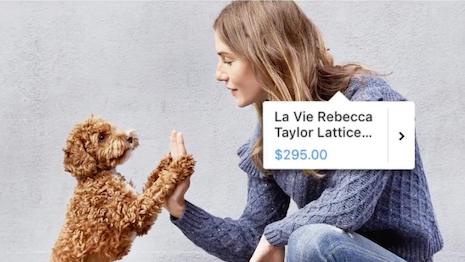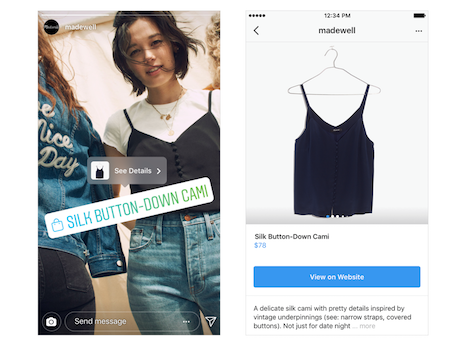 Shoppable Instagram post from Shopbop. Image credit: Instagram
Shoppable Instagram post from Shopbop. Image credit: Instagram
Social media platform Instagram is making additional moves into shopping as it increasingly positions itself as a place for commerce as well as conversations.
Instagram is rolling out Shopping on Stories to a wider array of brands as well as testing out a Shopping feature on its Explore hub. These launches come as the brand is said to be working on a standalone shopping application.
"We suspect Instagram Stories to be an important traffic generator and referral tool for brands, as it is the only place on Instagram where you can link to an external site, other than on the profile info section," said Pau Sabria, cofounder of Olapic, New York. "Swiping as a way of visiting sites is important, so to develop consumer behavior by tagging shoppable products makes a lot of sense.
"This news also validates the intent of Instagram to ultimately optimize its functionality, and provide brands with a superior experience and marketplace to promote and sell products," he said. "There have been rumors that Instagram may be developing a shopping app that is independent from the main platform experience.
"Right now though, they are still experimenting with shopping behaviors in different formats, which could inform the shopping app if that ever becomes a reality."
Mr. Sabria is not affiliated with Instagram, but agreed to comment as an industry expert. Instagram was reached for comment.
Social selling
Instagram began testing shopping in its ephemeral Stories feature earlier this year. At that time, only a select number of partner brands were able to try out these shoppable posts.
Now, it is bringing this option to all brands that are approved to use its shopping capabilities.
With Shopping in Stories, companies can place a product sticker within a Story to direct consumers to a page containing item details and suggestions of similar products. From here, the consumer can tap a link to navigate to the brand’s mobile site to make a purchase.
Shoppable Stories on Instagram. Image credit: Instagram
The landing page for this feature is the same as those generated for regular shopping posts, which feature shoppable tags that direct to items (see story).
Launched two year ago, Instagram Stories counts 400 million daily users today.
"Our recommendation to brands is to experiment with the formats that successfully lead to transactions on Stories," Mr. Sabria said. "We know dynamic content outperforms static, but in general, we advise brands that touch all vertical industries to focus on streamlining content production and performance measurement as a way to ensure video content created fits their sales goals. This will also help Stories evolve as a viable ecommerce channel."
Along with shoppable Stories, Instagram is running a test of a shopping channel in Explore. This section of its application allows consumers to discover content outside of their curated feed, showing them photos and videos from creators who they may not follow at the moment.
The shopping channel in Explore will be catered to the user’s particular shopping tastes.
Following a test, Instagram plans to roll out Shopping in Explore.
"It’s been rumored for some time that Instagram is planning to launch a shopping-only version of the flagship app," said Zack Holland, chief marketing officer of cloudten and CEO of the Holland Digital Group, New York. "Ahead of the launch of this shopping app, the Instagram team is working to integrate more commerce-driven features to the current experience to train users to click and purchase within the Instagram-world.
"The two new experiences will offer new ways to communicate with consumers, but in very different ways," he said. "Stories are built for informal, fun, movement-oriented communication that needs to grab a consumer before they simply swipe along. Because of this short attention span, seasonal or short-lived deals should preform well on Stories.
"On the opposite end of the spectrum, the Explore tab will be featuring the polished, professionally-shot product photography that we’ve come to know as the Instagram style. Shooting your products in innovative and artistic ways, as well as with recognizable influencers, will be necessary to stand out on an explore shopping experience with millions of other brands."
Today, Instagram sees 90 million accounts tapping product tags each month, showing the consumer interest in using it not just as a content platform but a shopping channel.
"Much as Facebook has been expanding shopping link in Messenger and in core Facebook pages, Facebook-owned Instagram is exploring opportunities to facilitate commerce for its base of millions of daily users," said Jason Oxman, CEO of the Electronic Transactions Association. "Because more than 25 million businesses have Instagram accounts, it is a logical extension of the Instagram experience to connect those businesses to customers.
"Instagram is about images, and with ecommerce sales in the U.S. still only about 10 percent of all retail purchases, merchants are exploring new ways to connect with customers online," he said. "The use of Instagram images to drive sales is logical. Consumers who see images of things they want should have an easy way to purchase them."
Purchasing priority
Luxury marketers’ strategies for Instagram should revolve around not only presenting attractive images, but achieving measurable business goals, according to the platform’s head of luxury.
Instagram offers luxury brands the opportunity to speak to a growing, global audience of 500 million daily users, who are turning to the platform to explore their passions, whether fashion or travel. Speaking at Women in Luxury 2017, the executive explained how a number of brands are mixing organic and paid media to drive both conversations and conversions (see story).
Instagram is reportedly developing a dedicated shopping platform that would have a significant impact on ecommerce should it come into fruition.
The Facebook-owned platform is already an immense draw to businesses and advertisers. Since many online businesses already rely on Instagram for exposure, a standalone shopping hub would pose a challenge to ecommerce solutions such as Shopify (see story).
"By adding stickers to Stories and a shopping tab to Explore, Instagram is clearly interested in expanding ecommerce activities on its platform," Mr. Oxman said. "And if Instagram moves forward with the plan to launch the IG Shopping standalone app, Instagram could be moving to challenge existing marketplace platforms more directly."
